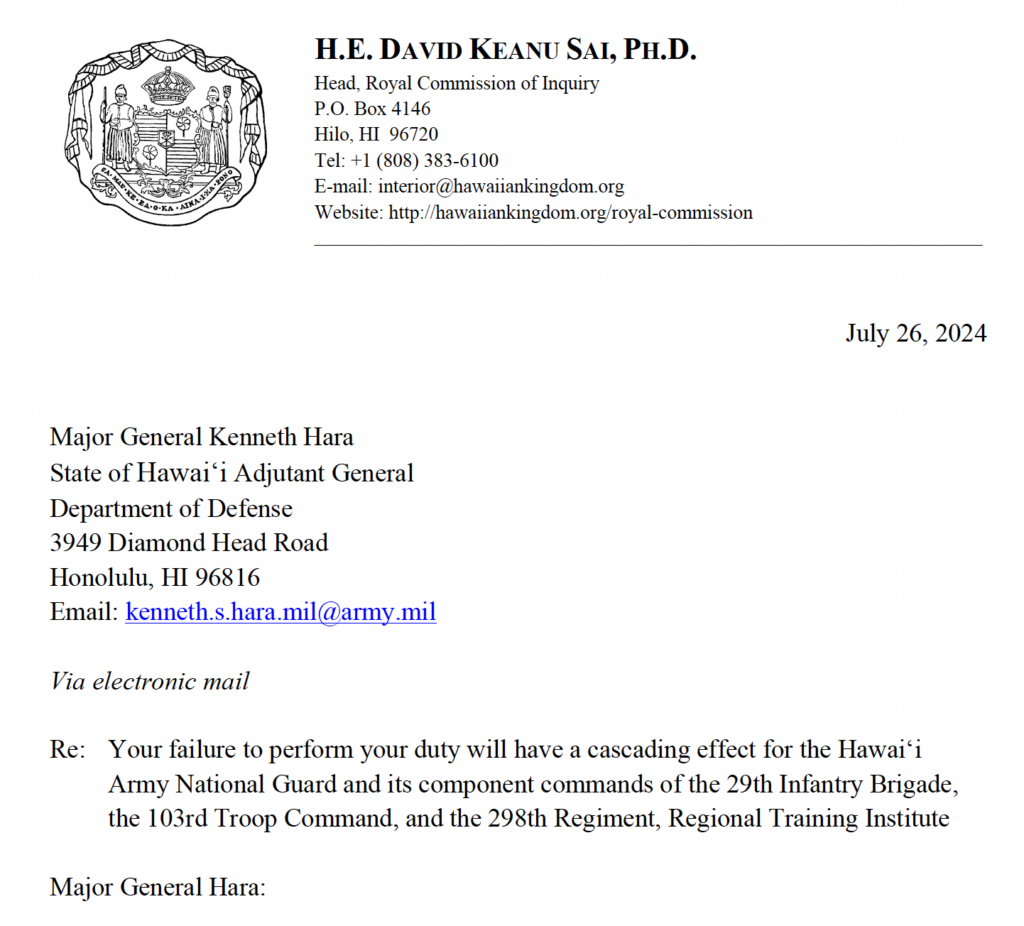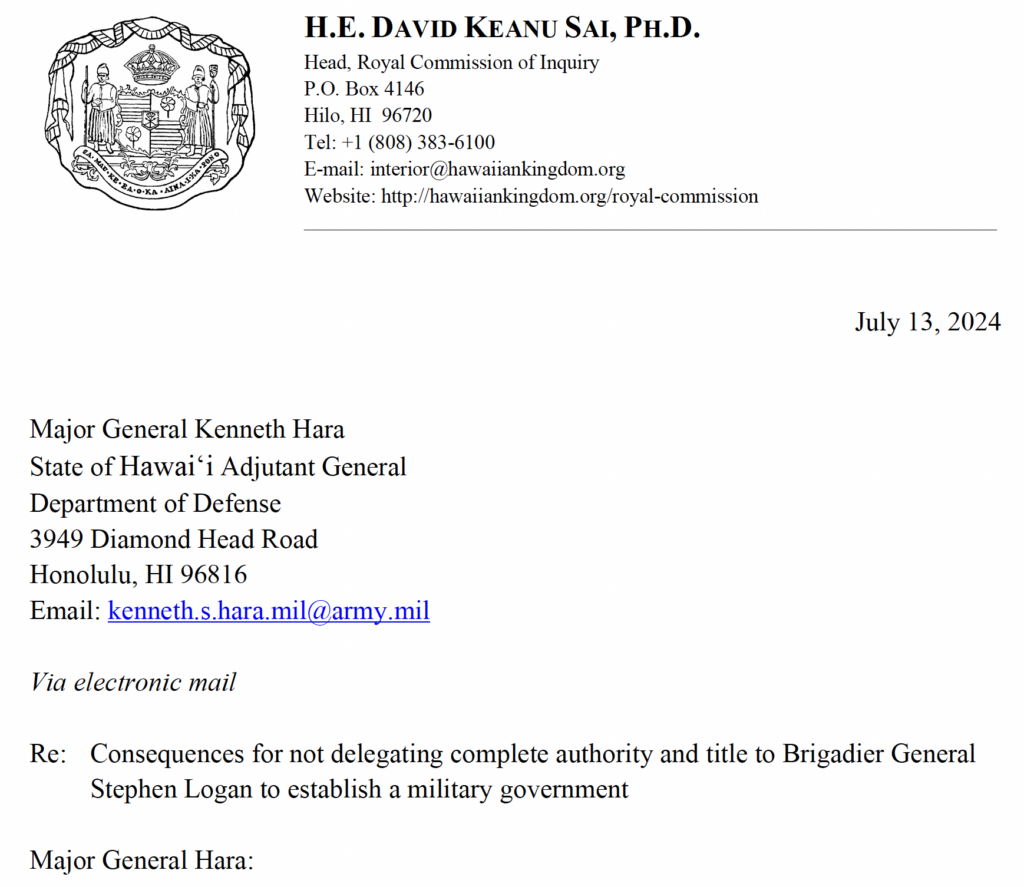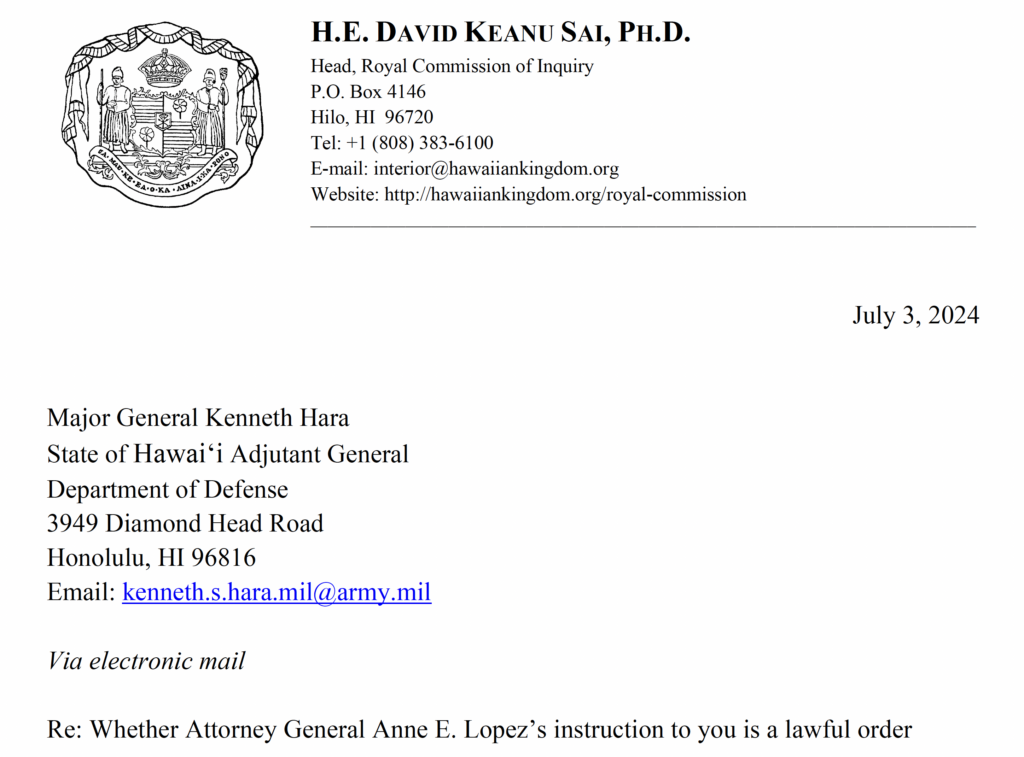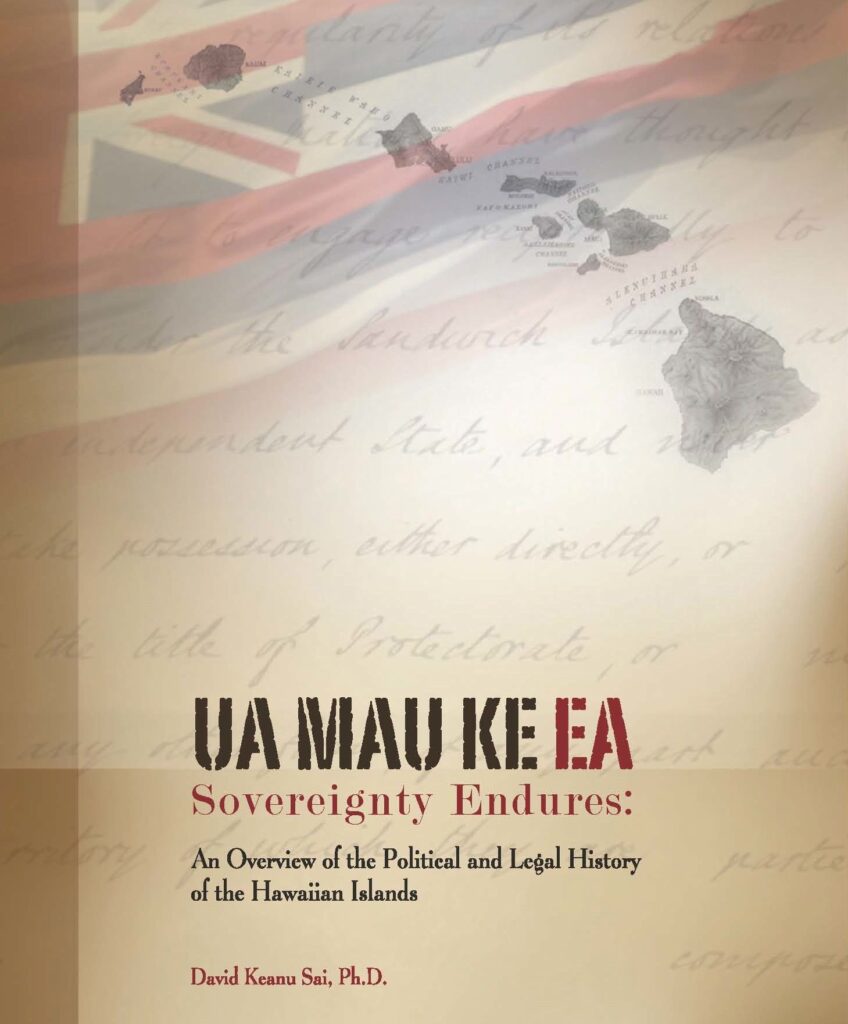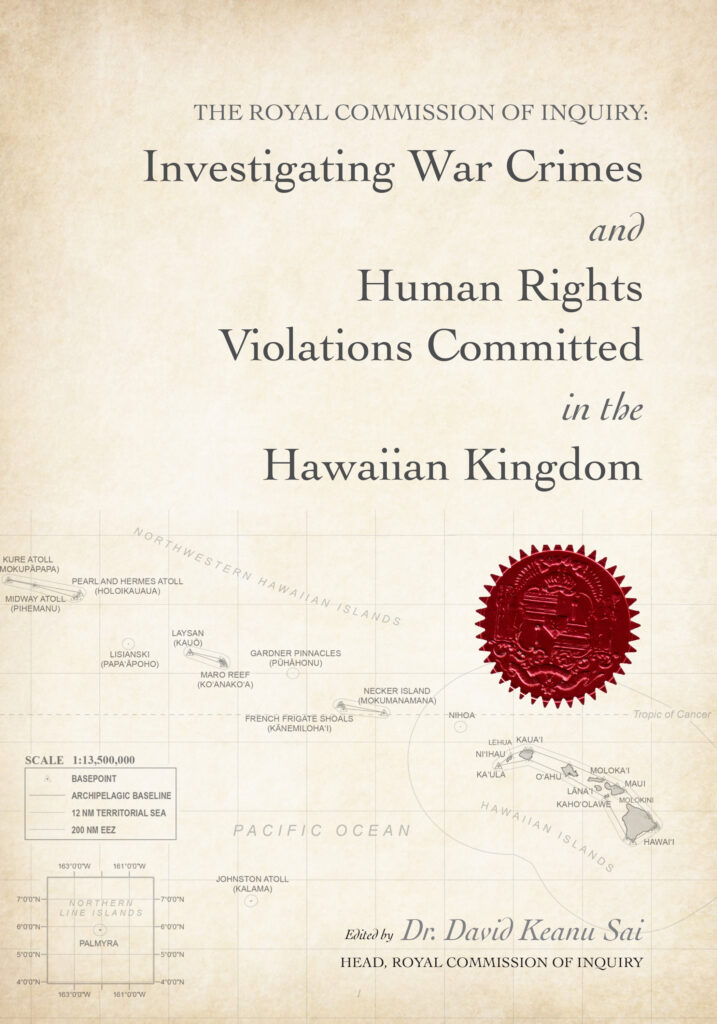On July 26, 2024, Dr. Keanu Sai, as Head of the Royal Commission of Inquiry, sent a letter to Major General Kenneth Hara on a cascading effect for the Hawai‘i Army National Guard and its component commands of the 29th Infantry Brigade, the 103rd Troop Command, and the 298th Regiment, Regional Training Institute, if he does not delegate complete authority and title to Brigadier General Stephen Logan to establish a military government by 1200 hours on July 31, 2024. Here is a link to the letter.
As July 31st is fast approaching, the chain of command of the Hawai‘i Army National Guard and its component commands of the 29th Infantry Brigade, the 103rd Troop Command, and the 298th Regiment, Regional Training Institute, will be drawn into criminal culpability for war crimes if you do not delegate complete authority to Brigadier General Stephen Logan to establish a military government by 12 noon on July 31, 2024.
After United States troops invaded and unlawfully overthrew the government of the Hawaiian Kingdom on January 17, 1893, international law required that the most senior military commander take control of the civilian government, that was overthrown, in order to continue to administer Hawaiian Kingdom law until there is a treaty of peace. The United States violated this rule of international law when they allowed an insurgency, they created, to unlawfully govern. In 1898, the United States began to impose American laws throughout the Hawaiian Kingdom, which is the war crime of usurpation of sovereignty. This illegal occupation has led to the establishment of 118 military sites throughout the Hawaiian Islands.
As you are aware, the current practice of the United States military imposes the responsibility on the Army to establish a military government to preside over occupied territory. Not the Navy, Marines, or Air Force. U.S. Department of Defense Directive 5100.1 states it is the function of the Army in “[occupied] territories abroad [to] provide for the establishment of a military government pending transfer of this responsibility to other authority.” And U.S. Department of Directive 2000.13 states the Army’s “Civil affairs operations include…[e]stablish[ing] and conduct[ing] military government until civilian authority or government can be restored.”
At the start of the twentieth century, the U.S. Army took steps to prepare for military occupations by publishing field manuals—FM 27-10, The Law of Land Warfare, FM 27-5, Civil Affairs Military Government, FM 3-57, Civil Affairs Operations, and FM 6-27, The Commander’s Handbook on the Law of Land Warfare. According to Article 42 of the 1907 Hague Regulations, territory is considered occupied when it is in effective control by the occupant, which triggers Article 43 to establish a military government to administer the laws of the occupied State.
Between the U.S. Federal government and the State of Hawai‘i, the latter is in effective control of 10,931 square miles, while the former is in effective control of less than 500 square miles. Thus, the duty to establish a military government is with the State of Hawai‘i Army National Guard and not with the U.S. Army Pacific under Indo-Pacific Combatant Command. This means that you are the theater commander under Army doctrine.
Paragraph 3, FM 27-5, states the “theater command bears full responsibility for [military government]; therefore, he is usually designated as military governor […], but has authority to delegate authority and title, in whole or in part, to a subordinate commander. In occupied territory the commander, by virtue of his position, has supreme legislative, executive, and judicial authority, limited only by the laws and customs of war and by directives from higher authority.”
In other words, the highest-ranking officer, in the theater of occupied territory, is duty bound to transform the civilian government of the occupied State into a military government. This government would be presided over by the Army theater commander who is called a “military governor.” Since the military governor “has supreme legislative, executive, and judicial authority, limited only by the laws and customs of war and by directives from higher authority,” the civilian government of the occupied State remains intact, except for the legislative branch.
Despite your announcement that you are retiring on October 1, 2024, you, as the theater commander, are obligated to begin the transformation of the State of Hawai‘i into a military government to administer Hawaiian Kingdom laws. The State of Hawai‘i’s governmental infrastructure is the civilian government of the Hawaiian Kingdom. What occurred since 1893 was a renaming of the civilian government from the Hawaiian Kingdom to the provisional government in 1893, the Republic of Hawai‘i in 1894, the Territory of Hawai‘i in 1900, and the State of Hawai‘i in 1959.
If you are derelict in the performance of your duties, by not delegating authority to BG Logan, then you would be the subject of a war criminal report by the Royal Commission of Inquiry (RCI) for the war crime by omission. From the date of the publication of your war criminal report on the RCI’s website, BG Logan will have one week to transform the State of Hawai‘i into a military government.
If BG Logan is derelict in the performance of his duties to establish a military government, then he would be the subject of an RCI war criminal report for the war crime by omission. From the date of the publication of BG Logan’s war criminal report on the RCI’s website, Colonel David Hatcher II, Commander of the 29th Infantry Brigade, who is next in the chain of command below BG Logan, will have one week to transform the State of Hawai‘i into a military government.
The chain of command, or what is called the order of battle, for the 29th Infantry Brigade for units in the Hawaiian Islands, is first, the 1st Squadron, 299th Cavalry Regiment, second, the 1st Battalion, 487th Field Artillery Regiment, third, the 29th Brigade Support Battalion, and fourth, the 227th Brigade Engineer Battalion. The 29th Infantry Brigade has units stationed in Alaska and Guam but since they are outside the Hawaiian territory, they do not have the military duty, as an occupant, to establish a military government in the Hawaiian Islands.
If Colonel Hatcher is derelict in the performance of his duties to establish a military government, then he would be the subject of an RCI war criminal report for the war crime by omission. From the date of the publication of Colonel Hatcher’s war criminal report on the RCI’s website, Lieutenant Colonel Fredrick J. Werner, Commander of 1st Squadron, 299th Cavalry Regiment, will assume command of the 29th Infantry Brigade and will have one week to transform the State of Hawai‘i into a military government.
If LTC Werner is derelict in the performance of his duties to establish a military government, then he would be the subject of an RCI war criminal report for the war crime by omission. From the date of the publication of LTC Werner’s war criminal report on the RCI’s website, Lieutenant Colonel Bingham L. Tuisamatatele, Jr., Commander of 1st Battalion, 487th Field Artillery Regiment, will assume command of the 29th Infantry Brigade and will have one week to transform the State of Hawai‘i into a military government.
If LTC Tuisamatatele is derelict in the performance of his duties to establish a military government, then he would be the subject of an RCI war criminal report for the war crime by omission. From the date of the publication of LTC Tuisamatatele’s war criminal report on the RCI’s website, Lieutenant Colonel Joshua A. Jacobs, Commander of 29th Brigade Support Battalion, will assume command of the 29th Infantry Brigade and will have one week to transform the State of Hawai‘i into a military government.
If LTC Jacobs is derelict in the performance of his duties to establish a military government, then he would be the subject of an RCI war criminal report for the war crime by omission. From the date of the publication of LTC Jacobs’s war criminal report on the RCI’s website, Lieutenant Colonel Dale R. Balsis, Commander of 227th Brigade Engineer Battalion, will assume command of the 29th Infantry Brigade and will have one week to transform the State of Hawai‘i into a military government.
Should LTC Balsis be derelict in the performance of his duties to establish a military government and be the subject of a war criminal report for the war crime by omission, that will be published on the RCI’s website, the sequence of events will then loop to the Executive Officers. First, with the 29th Infantry Brigade, second, with the 1st Squadron, 299th Cavalry Regiment, third, with the 1st Battalion, 487th Field Artillery Regiment, fourth with the 29th Brigade Support Battalion, and fifth with the 227th Brigade Engineer Battalion.
This looping, within the 29th Infantry Brigade’s component commands, will cover all commissioned officers to include Majors, Captains, First Lieutenants and Second Lieutenants. After the commissioned officers have been exhausted in the 29th Infantry Brigade, the chain of command of commissioned officers of the 103rd Troop Command and its component commands will begin, followed by the chain of command of commissioned officers of the 298th Regiment, Regional Training Institute, and its component commands. This sequence of events will continue by rank down the chain of command of the entire Hawai‘i Army National Guard until there is someone who sees the “writing on the wall” that he/she either performs their military duty or becomes a war criminal subject to prosecution.
As I stated to you before, to prevent all this from occurring, you must provide evidence that the Hawaiian Kingdom no longer exists as an occupied State under international law. To ignore this will have dire consequences for the Hawai‘i Army National Guard.

